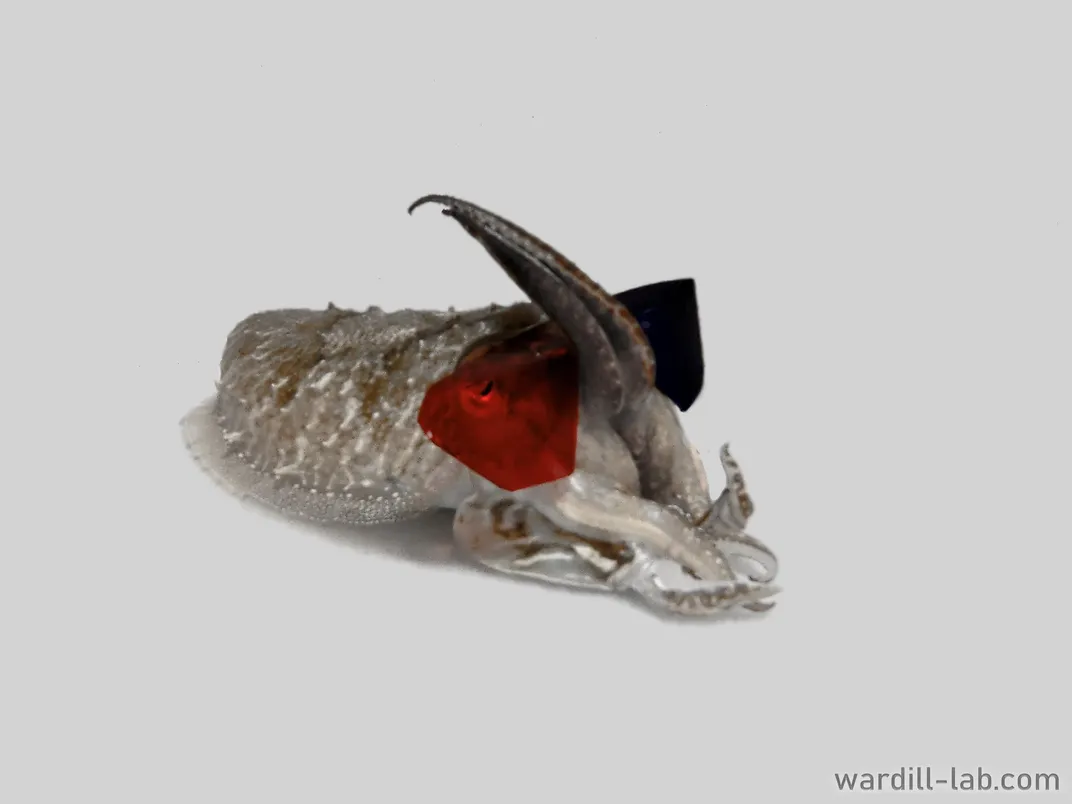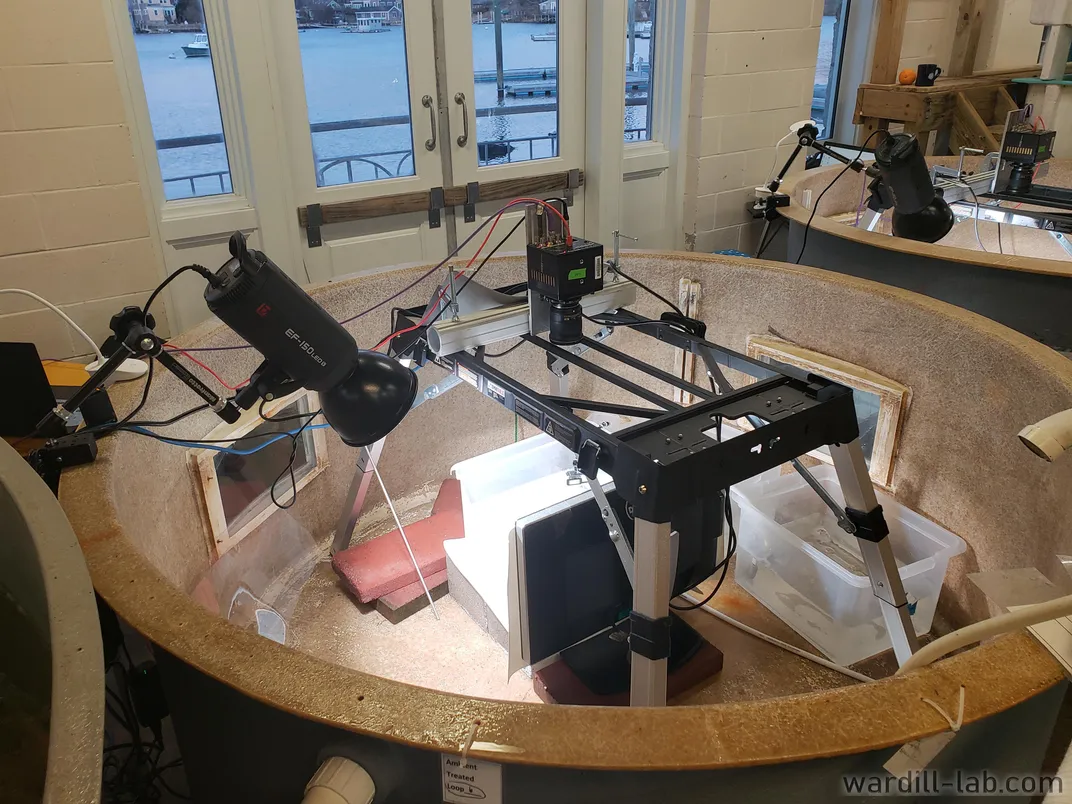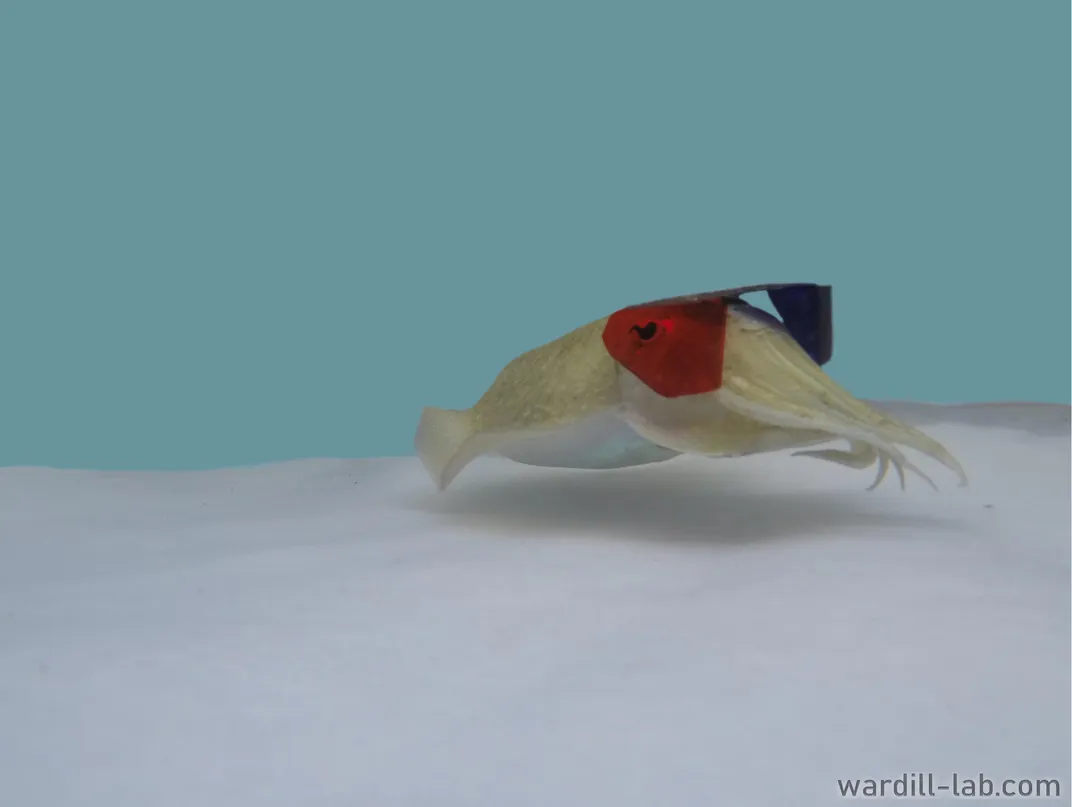Scientists Velcroed 3-D Glasses to Cuttlefish to Study Their Depth Perception
The results of the eye-popping study suggest cuttlefish see the world in surprisingly human ways
/https://tf-cmsv2-smithsonianmag-media.s3.amazonaws.com/filer/3c/d2/3cd21e2d-d0ac-4f95-b2bb-1d25fff05d21/cuttlefish_3d_glasses_3_wm_feord.jpg)
One of the world’s strangest 3-D cinemas is tucked away in a research laboratory in Woods Hole, Massachusetts. Its underwater interior lacks seats and aisles, and its screen measures only a few inches high. The patrons are European cuttlefish (Sepia officinalis): stout-bodied, color-changing relatives of squids and octopuses that deploy a pair of long, limber tentacles to snare their prey.
The film is in 3-D, though the rabbit-sized mollusks don’t take kindly to the blue and red glasses, says Trevor Wardill, a visual ecologist at the University of Minnesota. To get the spectacles to stick, Wardill and his students superglue a patch of Velcro onto the skin between the cuttlefish’s eyes, then affix the glasses on top. On first wear, most of the study subjects reach up with one of their many arms and snatch the lenses right back off.
But thanks to an abundance of grass shrimp treats, the cuttlefish eventually learn to tolerate their new accessories and watch the researchers’ feature films. With this unusual setup, Wardill and his colleagues have shown that cuttlefish perceive depth much like humans do: by comparing and combining the slightly offset images of the world that each of our eyes perceive, as reported today in Science Advances.

This visual trick, called stereopsis or stereo vision, requires complex coordination between the eyes and the brain, and it was once thought to be unique to vertebrates. Two years ago, another team led by Vivek Nityananda and Jenny Read of Newcastle University in the United Kingdom found stereo vision in the praying mantis—the first invertebrate to don 3-D glasses for the sake of science. Now, the cuttlefish brings the number of spineless creatures known to possess the trait up to two.
“We tend to take for granted some of the visual abilities that we humans have,” says Alex Nahm Kingston, a visual ecologist at the University of South Carolina who wasn’t involved in the study. “[Stereo vision] is what allows us to reach out and grab something off the kitchen counter or catch a ball. But this makes a great case for looking across lots of different groups … and seeing how animals interact with their environment in the most successful ways.”
Though a far cry from a human, big-brained cuttlefish are good candidates for stereo vision. Unlike their octopus and squid cousins, they swivel both their camera-like eyes forward when they hunt, seemingly calculating the distance between themselves and their grass shrimp prey. The petite, lithe and translucent crustaceans aren’t easy to snag, and misjudging the coordinates of a catch can leave a cuttlefish empty-tentacled. To successfully stalk shrimp, they need to judge depth as well as possible, says study author Rachael Feord, a visual ecologist at the University of Cambridge.

Taking inspiration from similar experiments with praying mantises, Wardill and his team searched for stereovision in 11 cuttlefish by situating them in a 3-D cephalopod cinema, similar to old-school 3-D theaters for people. Glasses, outfitted with two filters of different colors, showed each of their eyes a separate image of a tasty shrimp on the screen. If the mollusks were using stereo vision, the colored images would combine in their minds to create the illusion of depth, allowing them to calculate the ideal distance from which to attack their apparently three-dimensional “prey.”
Trained to treat the faux food as real, the bespectacled creatures struck out again and again. Depending on how close together the colored shrimp were, and the order they appeared in, the cuttlefish would either back up from the image or sidle up close—so much so that they’d often bash their tentacles against the screen itself.
Then the researchers switched things up. Instead of showing their subjects two colored images, they projected just one, effectively blinding one eye. Stripped of stereo vision, the cuttlefish took longer to position themselves in front of the screen. (The cephalopods weren’t completely flummoxed, though. Like human eyes, cuttlefish eyes, whether solo or in pairs, collect a bevy of visual cues to assess their surroundings.)
Taken together, these experiments make for “a really compelling demonstration of cephalopod stereopsis,” says Read, who wasn’t involved in the study. “I can’t think of any other explanation.”
But not all is equal in the eyes of cuttlefish and human. The team also presented the cephalopods with another set of shrimp projections, this time superimposed on backgrounds of colored patterns of dots, some bright, some dark. In humans, when one eye sees a pattern of bright and dark dots, and the other eye sees the inverse of the pattern—where the bright and dark dots are reversed—our brains have difficulty reconciling the differences, compromising depth perception. Remarkably, both praying mantises and cuttlefish are unfazed by these inverted background patterns. Rather than trying to come to grips with the conflicting intel, their brains just ignore it, and stereo vision proceeds unimpeded. (Unlike mantises, however, cuttlefish can’t see in 3-D when presented with a pair of images that look nothing alike.)
Of course, real grass shrimp (or any prey, for that matter) don’t spend much time scuttling across backdrops of neon dots. But Feord thinks the less stringent types of stereo vision present in the praying mantis and cuttlefish could constitute a powerful advantage. By filtering out some of the clutter in their surroundings, these invertebrates can focus on what’s important: their prey. “Humans form a very complex image that gets refreshed over and over in the brain,” she says. “The cuttlefish and praying mantis just pick out the elements they need without getting bogged down in the details.”
The researchers also found that cuttlefish, which can rotate their eyes independently of each other, don’t always focus both peepers on the same point, and the reason is still a mystery. “The positions of their eyes can be as much as 10 degrees apart,” Wardill says. “For us, that would be disastrous. We’d have trouble walking around.”
Then again, cephalopod brains aren’t exactly organized like ours (or like praying mantises’, for that matter), says study author Paloma Gonzalez-Bellido, also of the University of Minnesota, in a statement. While the human brain does most of its visual processing in a region called the occipital lobe, cephalopod neurology appears to be a bit more disorganized. Their brains, which are home to dozens of different lobes with overlapping functions, are pretty much “black boxes,” Wardill says.

Perhaps the most extraordinary finding is that the brains of dramatically different animals developed 3-D perception independently. Hundreds of millions of years have passed since humans, cuttlefish and praying mantises shared a common ancestor, and they all ended up eyeing the same visual strategy. The recurrence of this evolutionary trait underscores the importance of depth perception, says Judit Pungor, a cephalopod vision expert at the University of Oregon who wasn’t involved in the study.
And even more animals with this unusual ability are likely out there. Wardill and Gonzalez-Bellido’s previous work hints that predatory robber flies might use stereo vision, too. “For years, people thought that you could only do stereopsis if you had a very big [and complex] brain, because that’s how it is in humans,” Feord says. But the behavior clearly isn’t as rare as once thought.
Comparing the specifics of stereo vision in these creatures and others might someday help crack the molecular code that makes depth perception possible. “I think people should put more 3-D glasses on more animals,” says Nityananda, who helped pioneer the act in the praying mantis. “If that’s my lasting contribution to science, that’ll be good.”
/https://tf-cmsv2-smithsonianmag-media.s3.amazonaws.com/accounts/headshot/10172852_10152012979290896_320129237_n.jpg)


/https://tf-cmsv2-smithsonianmag-media.s3.amazonaws.com/accounts/headshot/10172852_10152012979290896_320129237_n.jpg)